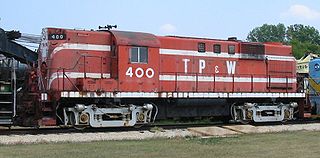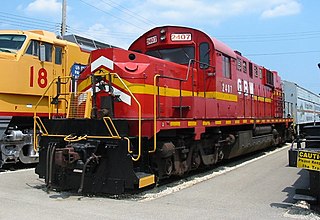
The American Locomotive Company was an American manufacturer of locomotives, diesel generators, steel, and tanks that operated from 1901 to 1969.

The ALCO Century 415 was a diesel-electric locomotive of B-B wheel arrangement produced by the American Locomotive Company (ALCO) as part of their Century Series of locomotives.

The ALCO S-1 and S-3 were 660 horsepower (490 kW) diesel-electric switcher locomotives produced by ALCO and their Canadian subsidiary Montreal Locomotive Works (MLW). The two locomotives differed only in trucks, with the S-1 using ALCO's own Blunt trucks, and the S-3 using AAR type A switcher trucks. The S-1 was built between April 1940 and June 1950, with a total of 543 completed, while the S-3 was constructed between February 1950 and November 1953 with total sales of 300. A modified version, the S-10, was built by MLW only; 13 were built between January and June 1958.

The ALCO HH series was an early set of diesel switcher locomotives built by the American Locomotive Company (ALCO) of Schenectady, New York between 1931 and 1940, when they were replaced by the S series: the 660 hp (490 kW) S-1 and 1,000 hp (750 kW) S-2. They were ALCO's first diesel switchers to enter true series production, and among the first land vehicles anywhere to use the revolutionary diesel-electric power transmission.

The Consolidation Line was a series of diesel-electric railway locomotive designs produced by Fairbanks-Morse and its Canadian licensee, the Canadian Locomotive Company. Railfans have dubbed these locomotives “C-liners”, however F-M referred to the models collectively as the C-Line. A combined total of 165 units were produced by F-M and the CLC between 1950 and 1955.

In rail transport, a cow-calf is a set of diesel switcher locomotives. The set usually is a pair; some three-unit sets were built, but this was rare. A cow is equipped with a cab; a calf is not. The two are coupled together and equipped with multiple unit train control so that both locomotives can be operated from the single cab.

The ALCO RS-11 is a class of diesel-electric locomotive rated at 1,800 hp (1.34 MW), that rode on two-axle trucks, having a B-B wheel arrangement. This model was built by both Alco and Montreal Locomotive Works. Total production was 426 units.

The ALCO RS-1 was a 4-axle diesel-electric locomotive built by Alco-GE between 1941 and 1953 and the American Locomotive Company from 1953 to 1960. ALCO subsidiary Montreal Locomotive Works built an additional three RS-1s in 1954. This model has the distinction of having the longest production run of any diesel locomotive for the North American market. The RS-1 was in production for 19 years from the first unit Rock Island #748 in March 1941 to the last unit National of Mexico #5663 in March 1960.

The ALCO RSD-15 is a diesel-electric locomotive built by the American Locomotive Company (ALCO) of Schenectady, New York between August 1956 and June 1960, during which time 75 locomotives were produced. The RSD-15 was powered by an ALCO 251 16-cylinder four-cycle V-type prime mover rated at 2,400 horsepower (1.79 MW); it superseded the almost identical ALCO 244-engined RSD-7, and was catalogued alongside the similar but smaller 1,800 hp (1.34 MW) RSD-12, powered by a 12-cylinder 251-model V-type diesel engine.

The ALCO RS-2 is a 1,500–1,600 horsepower (1,100–1,200 kW) B-B diesel-electric locomotive built by the American Locomotive Company (ALCO) from 1946 to 1950. ALCO introduced the model after World War II as an improvement on the ALCO RS-1. Between 1946 and 1950, 377 examples of the RS-2 were built, primarily for American and Canadian customers.

The ALCO S-2 and S-4 are 1,000-horsepower (746 kW) diesel electric switcher locomotives produced by ALCO and Canadian licensee Montreal Locomotive Works (MLW).

The ALCO FA was a family of B-B diesel locomotives designed to haul freight trains. The locomotives were built by a partnership of ALCO and General Electric in Schenectady, New York, between January 1946 and May 1959. Designed by General Electric's Ray Patten, they were of a cab unit design; both cab-equipped lead FA and cabless booster FB models were built. A dual passenger-freight version, the FPA/FPB, was also offered. It was equipped with a steam generator for heating passenger cars.

The Alco S-5 was a diesel-electric switcher locomotive rated at 800 horsepower (600 kW), that rode on two-axle trucks, having a B-B wheel arrangement.

The Alco 539T was a diesel prime mover built by the American Locomotive Company. This engine was also used as a stationary powerplant, used in pipeline pumping stations, tugboats and dredges. It has a straight-six, four-stroke design in a cast block which produced from 810 to 1,000 horsepower. The engine has a bore of 12.5 inches (318 mm), and a stroke of 13 inches (330 mm). The 539 engine was built at Alco's Auburn, New York engine plant and later starting in September 1949 in Canada. The 539T was equipped with the Buchi turbocharger, being made under license by the Elliott Manufacturing Company of Jeannette, Pennsylvania. The first 539T engines were used in S-2 switchers and DL-105 passenger locomotives built in September 1940. Alco locomotives using this engine include the S-2, S-4, RS-1, RSC-1, RSD-1, DL-105, DL-107, DL-108, DL-109, and DL-110. MLW locomotives using this engine include the S-2, S-4, S-7, S-12, RS-1, and RSC-13.
The ALCO 251 is a 4-stroke diesel engine that was developed by the American Locomotive Company to replace its 244 and 539 engines. The 251 was developed to be used in diesel locomotives, as a marine power plant in ships, and as a stationary power generator.
The GE Universal Series is a series of diesel locomotives intended for the export market introduced by General Electric in early 1956. General Electric had previously partnered with Alco, producing locomotives for export using Alco's 244 engine, and provided electrical parts for Alco's domestic production. However, with the advent of the Universal Series, GE ended its partnership with Alco and entered the export locomotive market on its own.

The GE boxcabs, sometimes also GE IR boxcabs, were diesel-electric switcher locomotives succeeding the ALCO boxcabs. The locomotives were built by General Electric and Ingersoll Rand without ALCO. Production lasted from 1928 to 1930. These boxcabs were often termed oil-electrics to avoid the use of the German name Diesel, unpopular after World War I.
Maine Central Railroad steam switchers were designated Class K. They were of 0-6-0 wheel arrangement in the Whyte notation, or "C" in UIC classification. American Locomotive Company (ALCO) began building more powerful yard locomotives for Maine Central in 1909. Twenty locomotives numbered 161 through 180 were active in 1923, and worked in Maine's largest cities until replaced by diesels after World War II.
Maine Central Railroad began operating diesel locomotives in 1935, and had retired all steam locomotives by 1954. That time interval was a joint operating period with the Boston and Maine Railroad (B&M). This article describes diesel locomotives owned by Maine Central through the period of joint operation and later independent operation prior to Guilford Rail System control in 1981.















